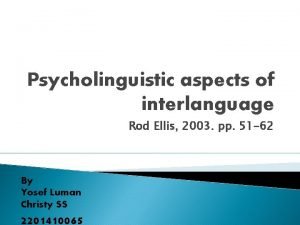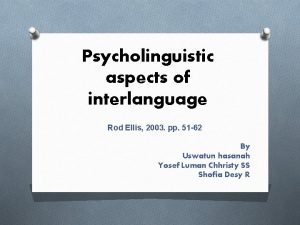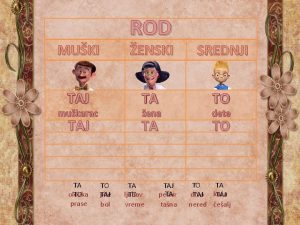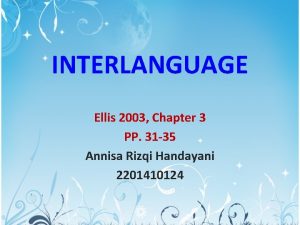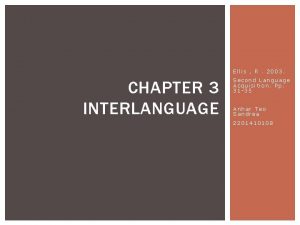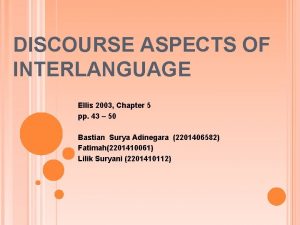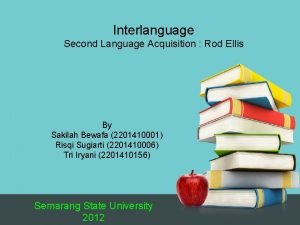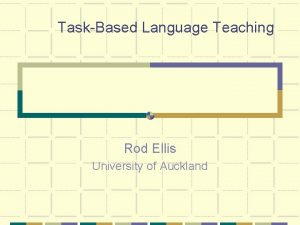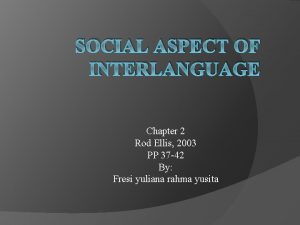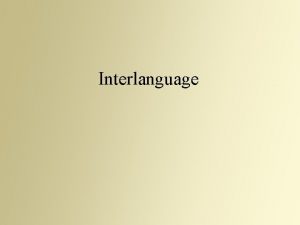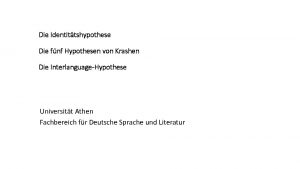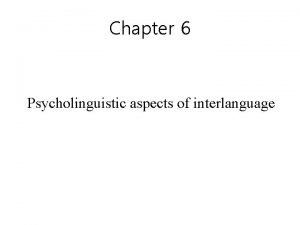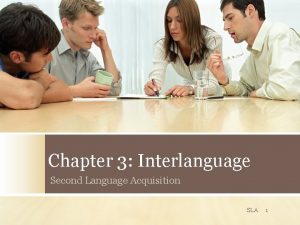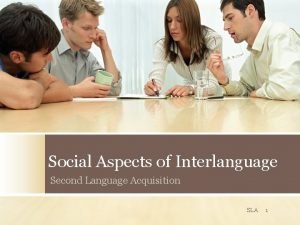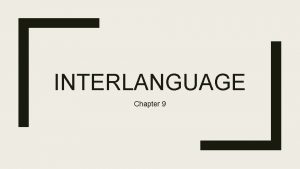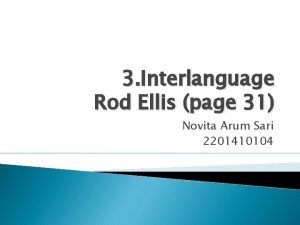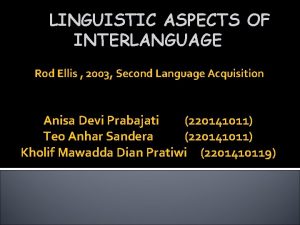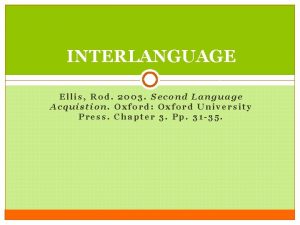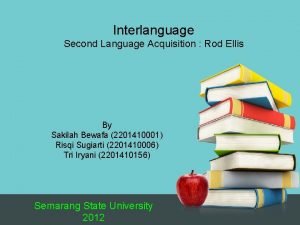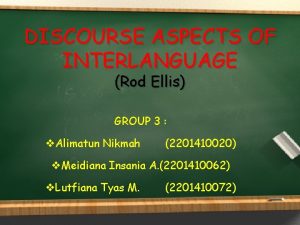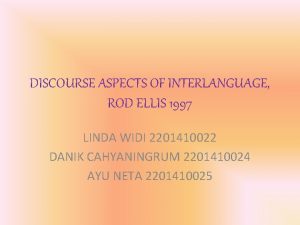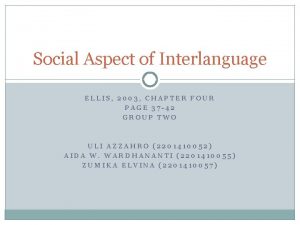Interlanguage Chapter 3 Rod Ellis 2003 Page 31

















- Slides: 17

Interlanguage Chapter 3 Rod Ellis, 2003 Page: 31 -35 By: Fresi Yuliana Rahma Yusita 2201410123

THE GOALS Behaviourist learning theory ü Mentalist theory of language learning ü What is ‘Interlanguage’ ? ü A computional model of L 2 acquisition ü

INTERLANGUAGE Earlier we noted that some researchers consider that the systematic development of learner langauge refelects a mental system of L 2 knowledge. This system is often reffered to as interlanguage. To understand what is meantby interlangauge we need to briefly consider behaviourist learning theory and mentalist views of language learning.

BEHAVIOURIST LEARNING THEORY The dominant psychology theory of the 1950 s and 1960 s was beahviourist learning theory. According to this theory, language learning is like any other kind of learning in that it involves habit formation. Habits are formed when learners respond ti stimuli in the enviroment and subsequently have their responses reinforced so that they are rembered. Thus, a habit is a stimulus-response connection.

BEHAVIOURIST LEARNING THEORY It was believed that all behaviour, including the kind of complex behaviour found in language acquisition, could be explained in terms of habits. Learning took place when learners had the opportunity to practise making the correct response to a given stimulus. Learners imitated models of correct language and received positive reinforcement if they were correct and negative reinforcement if they were incorrect.

BEHAVIOURIST LEARNING THEORY Behaviour cannot adequately account for L 2 acquisition. Learners frequently do not produce output that simply reproduce the input. Furthermore, the systematic nature of their errors demonstrates that they are actively involved in constructing their own ‘rules’, rules that sometimes bear little resemblance to the patterns of language modelled in the input.

A MENTALIST THEORY OF LANGUAGE LEARNING The obvious inadequacies of behaviourist explanations of L 2 acquisition led researchers to look towards an alternative theoretical framework. They did not have to look very far as the 1960 s witnessed a major shift in thinking in psychology and lingusitic.

IN THE 1960 S AND 1970 S A MENTALIST THEORY OF FIRST LANGUAGE (L 1) ACQUISITION EMERGED. ACCORDING TO THIS THEORY: � Only human beings are capable of learning language. � The human mind is equipped with a faculty for learning language, reffered to as a Language Acquisition Device. This is separate from the faculties responsible for other kinds of cognitive activity. � This faculty is the primary determinant of language acquisition. � Inout is needed, but only to ‘trigger’ the operation of the language acquisition device.

WHAT IS ‘INTERLANGUAGE’ ? In term ‘interlanguage’ was coined by the American linguist, Larry Slinker, in recognation of the fact that L 2 learners construct a linguistic system that draws, in part, on the learner’s L 1 but is also different from it and also from the target language. A learner’s interlanguage is, therefore, a unique linguistic system.

THE CONCEPT OF INTERLANGUAGE INVOLVES THE FOLLOWING PREMISES ABOUT L 2 ACQUISITION: � � � The learner constructs a system of abstract linguistic rules which underlies comprehension and production of the L 2. This system of rules is viewed as a ‘mental grammar’ and is reffered to as an ‘interlanguage’. The learner’s grammar is permeable. That is, grammar is open to influence from the outside. It is also influence from the inside. The learner’s grammar is transitional. Learners change their grammar from one time to another by adding rules, deleting rules, and restructuring the whole system. This is results in an interlanguage continuum. That is, learners construct a series of mental grammars or interlanguages as they gradually increase the complexity of their L 2 knowledge.

THE CONCEPT OF INTERLANGUAGE INVOLVES THE FOLLOWING PREMISES ABOUT L 2 ACQUISITION: � � � Some researchers have claimed that the systems learners construct contain variable rules. That is, they argue that learners are likely to have competing rules at any one stage of development. However, other researchers srgue that interlanguage systems are homogenous and that variability reflects the mistakes learners make when they try to use their knowledge to communicate. Learners employ various learning strategies to develop their interlanguages. The different kinds of errors learners produce reflect different learning strategies. The learner’s grammar is likely to fossilize. The prevalence of backsliding is typical of fossilized learners. Fossilization does not occur in L 1 acquisition and thus is unique to L 2 grammars.

WHAT IS ‘INTERLANGUAGE’ ? This concept of interlanguage offers a general account of how L 2 acquisition takes place. It incorporates elements from mentalist theories of linguistic (i. g. the nation of a ‘language acquisition device’) and elements from cognitive psychology (i. g. ‘learning strategies’).

A COMPUTIONAL MODEL OF L 2 ACQUISITION The concept of interlanguage can be viewed as a methaphor of how L 2 acquisition takes place. It implies that the human mind functions like a computer. Figure 3. 1 reprents the basic computational metaphor that has grown out of ‘interlanguage’ and that informs much of SLA.

A COMPUTIONAL MODEL OF L 2 ACQUISITION The learner is exposed to input, which is processed in two stages. First, parts of it are attended to and taken into short-term memory. These are reffered to as intake. Second, some of the intake is stored in long-term memory as L 2 knowledge. The processes responsible for creating intake and L 2 knowledge occur within the ‘black box’ of the learner’s mind where the learner’s interlanguage is constructed. Finally, L 2 knowledge is used by the learner to produce spoken and written output.

A COMPUTIONAL MODEL OF L 2 ACQUISITION Intake Input L 2 knowledge output

A COMPUTIONAL MODEL OF LANGUAGE LEARNING As we shall shortly see, this basic model of L 2 acquisition can be elaborated in anumber of ways. For example, a component labelled ‘social context’ might be added to explain how the nature of the input varies from one setting to another. The ‘L 2 knowledge’ component can be broken up into two or more components to reflect the different kinds of knowledge learners construct. An arrow can be drawn from ‘output’ to ‘input’ to show that what a leraner says or writes can also serve as samples of language from which intake can be derived.

THANKYOU
 Rod ellis 2003
Rod ellis 2003 Rod ellis 2003
Rod ellis 2003 Mnozina od prase
Mnozina od prase Ellis 2003
Ellis 2003 Ellis 2003
Ellis 2003 Ellis 2003
Ellis 2003 Interlanguage theory
Interlanguage theory Rod ellis task based learning
Rod ellis task based learning Apa titling
Apa titling Ano ang interference phenomenon sa wika
Ano ang interference phenomenon sa wika Stylistic continuum in interlanguage
Stylistic continuum in interlanguage Stylistic continuum in interlanguage
Stylistic continuum in interlanguage What is interlanguage
What is interlanguage Interlanguage hypothese
Interlanguage hypothese Types of intralingual errors
Types of intralingual errors Psycholinguistics aspects of interlanguage
Psycholinguistics aspects of interlanguage Interlanguage sla
Interlanguage sla Interlanguage and acculturation
Interlanguage and acculturation
